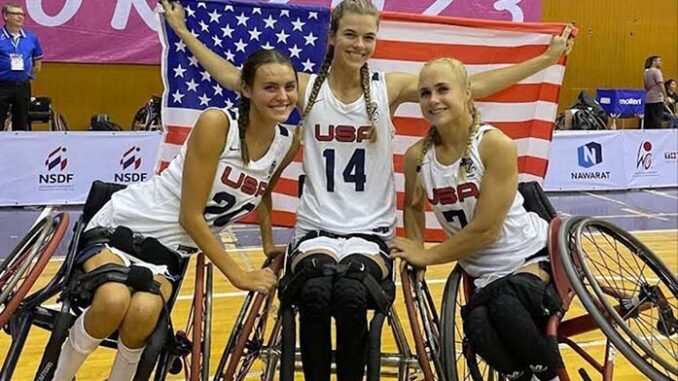
TUCSON – The warm southern desert air hit the faces of Abby Dunn, Emilee Gustafson and Hayley Nilsen as they left the comforts of home and hopped on a quick flight to Colorado, for the chance of a lifetime.
A dream since their teenage years, the Arizona Wildcats trio arrived at the doors of the world-class U.S. Olympic and Paralympic Training Center in Colorado Springs, where their grueling practices culminated in a life-changing training camp.
And from there, the three UArizona athletes journeyed to Bangkok, Thailand, where they not only won gold medals in their chosen sport on the national stage while representing Team USA, but returned with a fresh arsenal of ideas for an already-successful Wildcats program.
The three participate in wheelchair basketball, which is a part of adaptive athletics. But what exactly is adaptive athletics and what does it contain?
Adaptive sports are competitive or recreational sports for people with disabilities and they grant modifications for people with different disabilities in order to compete in the sport. With modifications, the sports are inclusive for all athletes to participate.
Sitting volleyball, for example, is played with all of the players sitting on the floor with the net lowered, and athletes must have one buttock cheek on the floor when making contact with the ball.
Sled hockey is another popular adaptive sport that requires its players to be seated on a sled with two ice picks to move around on the ice.
RELATED STORY Wheelchair basketball event brings top teams, Paralympians to Ability360
Adaptive sports have a unique beginning. They were first introduced as a way to rehabilitate veterans of World War II, Korea and the Vietnam War. Jim Winthers, a World War II veteran who specialized in alpine warfare, was one of the sport’s trailblazers.
After the war in 1953, he taught two of his friends who had also lost legs in combat to ski on one leg. From there, adaptive sports have taken off to include an array of games and events for people who have disabilities.
With any sport, recruiting plays a major factor in helping to guide athletes to where they eventually end up. With that, adaptive sports have different ways of recruiting athletes for both college and the national level.
“I feel like it was different for all of us,” Dunn said. “I was recruited during COVID, so I didn’t get a campus tour like recruits do. I got a Zoom call and also signed without a coach which turned out to be the best decision I could’ve made.”
Nilsen’s experience with the recruiting process was far more hands-on.
“I did get a recruitment visit my year so to see the team regrow (because we have seven sophomores) and see them practice and see the campus and to stay in touch with the coaches was a good experience,” Nilsen said.
Gustafson, meanwhile, saw the process as a means to a very good ending.
“My class was kind of crazy,” Gustafson said. “We weren’t technically collegiate yet until we got our five my freshman year and somehow we managed to get exactly five freshmen. That’s how our team started. I got recruited without seeing the previous team. I only met (one of) the coaching staff. We were just blind when we came in (and) kind of caught off guard by what we’re expecting, but it ended up working out.”
With Team USA, the recruitment process is different – the athletes have to apply via an application that includes sending in highlights. From this application, selected athletes are invited to the camp for tryouts.
“In that camp, it’s just like a training camp. They select the team and then the alternates but you have to apply to even be invited to this camp,” Dunn said.
After a quick but productive training camp at the Olympic and Paralympic Training Center in Colorado Springs, the trio and the rest of the women’s team were off to Thailand, for the U25 International Wheelchair Basketball Federation championships.
“We started off in Tucson together and we went to a send-off camp, which I thought was really cool. We got to hang out as a team in Colorado Springs (and) train for two more days before we headed out on a 30-plus hour trip to Bangkok,” Dunn said. “(It was our) first time going international.”
The everyday college training camp is nothing to take lightly while preparing for tournaments, but training to represent the country is a different beast.
Training camps usually last six days, which include four days of actual training and two travel days, each for arrival and departure from the camp.
“There’s usually like three sessions a day [that last] two and half hours,” Dunn said. “Training camp usually consists of conditioning, lifting and scrimmages. (In the scrimmages) there’s a lot of different lineups, which I think is really fun.”
The national team’s special treatment does not end there. The USA facilities give athletes the best experiences on and off the court.
“I would say everyone really likes the food there. There’s lots of different options,” Dunn said. “It’s kind of cool seeing all the other athletes there and like who’s all there at the time you’re there and then obviously, like, there are a lot of other resources like an athletic trainer.”
Despite the quick turnaround and few chances to engage with teammates from all over the country, the trio and Team USA had the 30-hour flight to quickly bond before competition started.
“I think it just helped because we didn’t get many opportunities to play together besides the two training camps we had,” Nilsen said. “So kind of getting to get closer off the court helped us with our chemistry on the court just because we didn’t get that much time for actually playing together because we’re kind of all from all over.”
While in Bangkok, the United States swept through the competition in dominating fashion, going 7-0 in its games. In the gold medal game on Oct. 9, Team USA defeated Great Britain 72-49 to win its third gold medal overall at the IWBF games.
Gustafson averaged six points, three rebounds and two assists off the bench for the U.S., while Nilsen averaged just under two rebounds a game off the bench.
After winning the gold in Thailand, the trio used their new experiences to help bolster an already dominant program at the UArizona.
“We kept talking about it when we got back here, but we’re just like Thailand was a trip. We just like it felt like a different simulation,” Gustafson said. “It was just what we’ve all been like practicing and playing for, and we finally got to show out on a whole other level.
“And to bring that back to Arizona to our teammates and our coaches, it lets us show them like yeah, ‘We did that (and) you guys can do that too.’”
UArizona quarters the largest and most successful adaptive athletic program in the country. With seven competitive teams, the school is on a continuous search to add more programs. The school offers eight sports, including men’s and women’s basketball, para swimming, golf, handcycling, rugby, tennis, track and road racing.
Adaptive athletics has grown exponentially over the past 10 years. With more sport participation in adaptive sports and plenty of support, the sports are only getting bigger each year. A major catalyst for this growth was the Rio Paralympics Games in 2016.
The Wildcats trifecta reflected on the future of adaptive athletics while cherishing the opportunity in Tucson.
“Growth,” Gustafson said. “I wouldn’t change it. Like all the way through I knew I made the right decision (to come to Arizona).”
“It’s just surreal how it all has come (together) since we began playing with each other,” Dunn said.
The Wildcats recently went 1-4 in their tournament at the University of Texas-Arlington, but the losses do not go against their collegiate record. The team is looking ahead to its next tournament on Dec. 1 at the University of Wisconsin-Whitewater.
